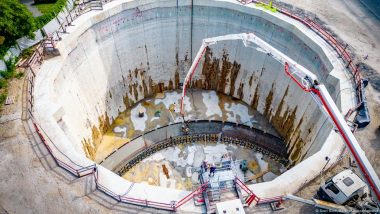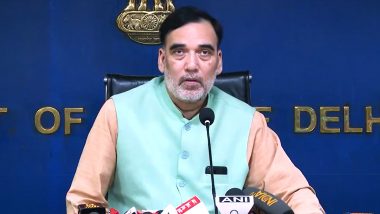Germany's capital has a problem with rising temperatures and drought. So the city has come up with solutions for how to collect and store rainwater by turning Berlin into a sponge city.Berlin is located in a dry region of Germany and water supply is a hot topic in summer. That's why the city is adopting measures to absorb and store rainwater like a sponge and release it when water is needed.
Also Read | India News | Whether Apology Published in Newspapers Where Interview Was Carried: SC Asks IMA President.
But how exactly is that being done?
Also Read | Business News | TVS Motor Continues Strong Growth Momentum; Records Highest Revenue, EBITDA and PBT in Q1.
Building underground wastewater storage facilities
The first step was to build several massive underground overflow basins. They work like huge wastewater parking areas. When it rains, water from the surrounding area is collected in the basin and then pumped to a treatment plant.
Nine of these facilities have already been completed, including under Mauerpark, a popular hangout spot in the district of Prenzlauer Berg, where part of the Berlin Wall once stood.
The largest inner-city wastewater basin is still in the making. It will be more than twice the size of the one at Mauerpark. At 30 meters (98.4 feet) deep in the ground, the circular concrete basin will hold nearly 17,000 cubic meters of rainwater once it's completed by 2026. That's equivalent to almost seven Olympic-sized swimming pools.
Reducing sewage overflows
When there's heavy rain and Berlin's sewage system is at risk of running over, surplus water is stored in the basins. It's then pumped into a purification plant before being released back into Berlin's canals and rivers once the rain has stopped.
This will prevent feces and wastewater from being flushed into the Spree River during heavy rain, said Astrid Hackenesch-Rump, a spokesperson for Berlin's water works BWB. The BWB is responsible for drinking water supply, as well as management and treatment of wastewater across the city.
"The driving force behind this program was not only resource conservation and drought, but rather to prevent combined sewage overflows," said Hackenesch-Rump.
Such overflows occur in combined sewage systems, where stormwater runoff and domestic sewage are collected in the same pipe network. These systems were originally designed to carry all the wastewater to a treatment plant before it is discharged into natural water bodies.
However, during heavy rainfall, the volume of water entering the system can exceed its capacity. When this happens, the excess water — consisting of stormwater and untreated sewage — overflows directly into nearby rivers.
Some 2,000 of the 10,000 kilometers of city's sewers are combined sewage systems with overflows at 180 locations. These are basically openings in the sewage system that lead into the Spree River, Hackenesch-Rump explained.
Berlin's waterways are also fairly small and slow moving compared to those in other cities. Take a large river like the Rhine, which runs through many urban areas, including Cologne. It has an average flow rate of 2,200 cubic meters per second and can thus clean itself.
"We have flow rates in Berlin of less than 10 cubic meters per second, so whatever has flowed in will naturally remain there for quite some time," said Hackenesch-Rump.
"That's why these sewage overflows regularly lead to fish being killed and oxygen depletion in the waters," she added.
However, water planners soon realized that the basins could only fix part of the problem because so much of the city is sealed in concrete and impermeable surfaces.
"That means we were no longer able to achieve the goal of reducing overflows. Instead, we maintained the status quo, meaning that if we hadn't built [the basins], it would have been even worse," she said.
Turning Berlin into a sponge city
Berlin has already built on most of its open spaces where water could once percolate into the ground. So, when there's a lot of rain, instead of being sucked up by soil and plants, water flows off the concrete or asphalt and can end up mixing with sewage.
"One percent more sealing results in a 3% increase in overflows," Hackenesch-Rump added.
That's why the Berlin Senate and water utility BWB founded a "rainwater agency." The agency advises urban planners on ways to green roofs and buildings and to come up with innovative ideas for collecting and storing rainwater so it doesn't mix with sewage.
The city of Berlin has passed a law stipulating that only a small amount of rainwater on a new building properties can flow into the sewage system. The rest has to either evaporate or seep into the ground.
For example, one new apartment block was built with a large pond that collects rainwater. Adjacent plants help purify the water, which can then be used for irrigation.
Greening measures like this also help keep temperatures down and protect against flash flooding events.
"To solve the water crisis, people's willingness to think beyond boundaries is required, even if it's just thinking beyond one's own property line," said Hackenesch-Rump.
Edited by: Anke Rasper
(The above story first appeared on LatestLY on Aug 06, 2024 06:00 PM IST. For more news and updates on politics, world, sports, entertainment and lifestyle, log on to our website latestly.com).














 Quickly
Quickly












 RCB
RCB







